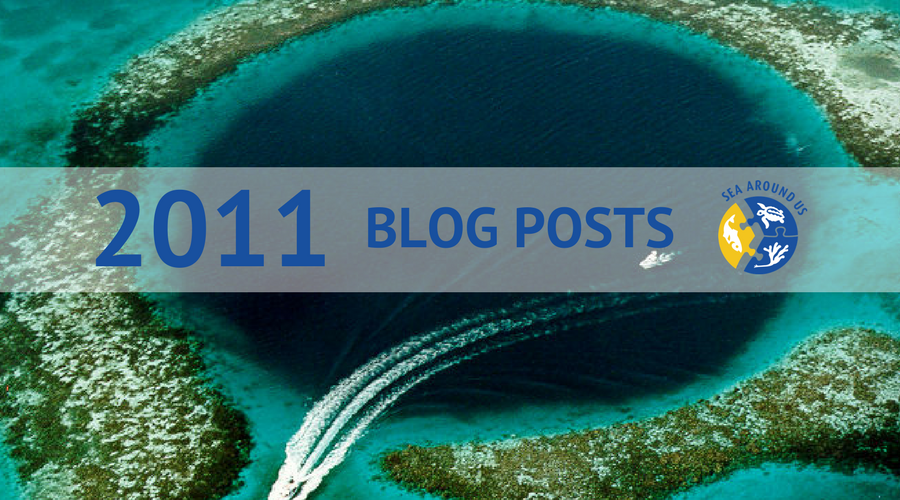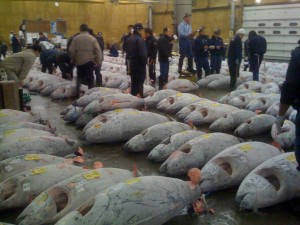 Iconic marine predators such as sharks, tunas, swordfish, and marlins are becoming increasingly rare under current fishing trends, according to a new study published in the journal Marine Ecological progress Series. In half of the North Atlantic and North Pacific waters under national jurisdiction, fishing has led to a 90-per-cent decrease in top predators since the 1950s, and the impacts are now headed south of the Equator. The study was lead authored by former Sea Around Us Project M.Sc student Laura Tremblay-Boyer. The study is available here and the press release is here.
Iconic marine predators such as sharks, tunas, swordfish, and marlins are becoming increasingly rare under current fishing trends, according to a new study published in the journal Marine Ecological progress Series. In half of the North Atlantic and North Pacific waters under national jurisdiction, fishing has led to a 90-per-cent decrease in top predators since the 1950s, and the impacts are now headed south of the Equator. The study was lead authored by former Sea Around Us Project M.Sc student Laura Tremblay-Boyer. The study is available here and the press release is here.
2011 blog posts
Analysis of FAO Report on Fisheries Statistics
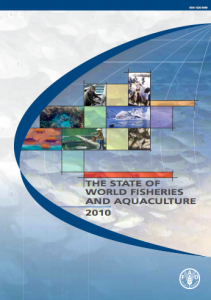 Global fisheries statistics must be viewed with a critical eye. Fisheries landings data are collated by FAO and contributed by all member countries, which have varying resources and motives. In a new paper recently published in Marine Policy, Daniel Pauly and Rainier Froese take a close look at FAO’s State of the Worlds Fisheries and Aquaculture’ (SOFIA) report from 2010 and discuss the FAO’s history, as well as the implications, imperfections, and possible improvements to be made to fisheries data.
Global fisheries statistics must be viewed with a critical eye. Fisheries landings data are collated by FAO and contributed by all member countries, which have varying resources and motives. In a new paper recently published in Marine Policy, Daniel Pauly and Rainier Froese take a close look at FAO’s State of the Worlds Fisheries and Aquaculture’ (SOFIA) report from 2010 and discuss the FAO’s history, as well as the implications, imperfections, and possible improvements to be made to fisheries data.
Pauly and Froese are both complimentary and critical. They point out the misleading use of the word ‘stability’ in the report as it refers to global catch data from 2005-2008, and point out that even if that global catches are indeed stable, fishing effort is rapidly expanding. They note the FAO’s acceptance of scientific data that showed China does not know how much its fisheries catch, and the large degrees of uncertainty around global trends this problem creates. Pauly and Froese point approvingly to SOFIA’s position on assemblage overfishing and their statement: ‘ We do not disagree that a general decline in mean trophic level of marine landings is likely to have occurred in many regions.’ Finally, Pauly and Froese call for cooperation between institutions, e.g., U.N. technical organization and civil society, as represented by universities and non-government organizations, to improve SOFIA reports and potentially the management of fisheries globally.
To read the full article click here.
Citation: Pauly, D. & Froese, R. 2012. Comments on FAO’s State of Fisheries and Aquaculture, or ‘SOFIA 2010’ Marine Policy 36: 746-752.
Climate Change to Further Degrade Fisheries Resources
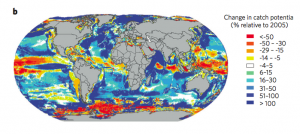 A new study out this week shows how the effect of climate change can further impact the economic viability of current fisheries practices.
A new study out this week shows how the effect of climate change can further impact the economic viability of current fisheries practices.
“Fisheries are already providing fewer fish and making less money than they could if we curbed overfishing,” says Rashid Sumaila, principal investigator of the Fisheries Economics Research Unit at UBC, member of the Sea Around Us Project, and lead author of the study. “We could be earning interest, but instead we’re fishing away the capital. Climate change is likely to cause more losses unless we choose to act.”
Partly supported by the Pew Charitable Trusts, National Geographic, the World Bank and U.S. National Oceanic and Atmospheric Administration, the study is a broad view of the impact of climate change on fisheries and their profitability. It was published online this week in the journal Nature Climate Change.
Over the last century the ocean has become warmer and more acidic. Other human-led factors, such as pollution and overfishing, have also been hard on marine species. With ocean warming, many species will move further towards the poles and into deeper water.
While fisheries in a few regions, such as the far north, may benefit from climate change, many other regions, particularly those in the tropics, can expect losses in revenues. Regional examples can help inform what could happen globally. For example, the reduction in landings of pelagic fisheries in Peru as a result of changes in sea surface temperature during the 1997-1998 El Niño event caused more than US$26 million of revenue loss.
“Changes in temperature and ocean chemistry directly affect the physiology, growth, reproduction and distribution of these organisms,” says William Cheung, associated faculty of the Sea Around Us Project. “Fish in warmer waters will probably have a smaller body size, be smaller at first maturity, with higher mortality rates and be caught in different areas. These are important factors when we think of how climate change will impact fisheries.”
“This study provides an early glimpse of how climate change might impact the economics of fishing,” says Sam Herrick, a NOAA scientist and co-author. “We must continue to study how climate change, combined with other factors, will affect marine ecosystems and the productivity of fishery resources.”
Biologically, maintaining more abundant populations can help increase fish’s capacity to adapt to environmental change. Curbing overfishing is crucial to making marine systems more robust and ready for changes that are already underway.
“This study highlights the potential negative impacts of climate change on the profitability of fisheries,” said Vicky Lam, UBC graduate student and co-author. “The next generation of scientists must put more effort on exploring ways to minimize the impacts of climate change.”
Fish stocks will also be more robust to climate change if the combined stresses from overfishing, habitat degradation, pollution runoff, land-use transformation, competing aquatic resource uses and other anthropogenic factors are minimized
“We have to remember that the effect of climate change on the marine environment will occur alongside the impacts on land,” says Daniel Pauly, principal investigator of the Sea Around Us Project and co-author. “It will not be easy to divert resources from one sector to help another sector. This is why a strong governance system is needed – to temper the losses on the sectors that are worst hit.”
“Governments must be anticipatory, rather than reactive,” says Sumaila. “We all need to think more of the future while we act now.”
For more information, see this summary provided by Pew.
Applying Science in Belize: from Taxonomy to Policy
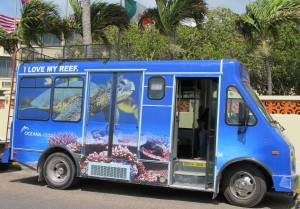 This article was written by research assistant, Sarah Harper, and appears in the July/August 2011 newsletter.
This article was written by research assistant, Sarah Harper, and appears in the July/August 2011 newsletter.
The Sea Around Us project and Oceana team up for a conference to discuss what’s at risk, from a marine biodiversity perspective, if plans go ahead to drill for oil off the coast of Belize. The conference, co-hosted by Daniel Pauly and Deng Palomares, held in Belize City on June 29 and 30th was entitled Too precious to drill: the marine biodiversity of Belize. At the conference marine biologists, taxonomists and economists provided an exhaustive list of reasons the precious and pristine marine environment of Belize could be at risk. With some of the healthiest coral reefs, manatee populations, shark diversity and reef fish spawning aggregations in the Caribbean, Belize would lose a lot from an oil spill1. Tourism and fisheries are particularly at risk as these both rely on a healthy marine environment, and provide jobs, revenue and food to the people of Belize.
Just over a year ago, the International NGO Oceana, which recently opened an office in Belize City, caught wind of plans to develop an offshore oil industry in Belize. Leaked govermnment documents revealed a map of the territorial waters of Belize, a checkerboard of oil exploration consessions. Oceana, the largest international NGO focused solely on ocean conservation, raised the alarm bell and decided that quick action was needed to engage and empower the people of Belize to stand up to the government and protect their precious natural wealth. A campaign was launched with a petition to be signed by the people of Belize demanding a referendum on oil exploration offshore and in protected areas. Oceana met their target with over 10% of the voting population signing the petition (17,000+ signatures), the minimum requirement for a referendum to be called, and continues to raise awareness throughout the country with their colourful campaign bus (see photo) and heavy media engagements.
Further to their in-country efforts to engage the public, Oceana teamed up with the Sea Around Us project to deliver the scientific evidence required for a strong case against offshore drilling in Belize. A conference was set for the end of June 2011 and international scientists selected to share their expertise, including Andrés Cisneros-Montemayor, Dirk Zeller and myself. One of the goals of the conference was to repatriate the knowledge and expertise that had been gleaned from years of scientific study within Belize but that had not necessarily stayed within its borders. Many detailed studies have been conducted on diverse aspects of the Belizean marine environment but have been published abroad. The conference aimed to bring this knowledge back to Belize and use it as a tool to inform and improve decision-making.
Attendance at the two-day conference included fishers, government deligates, the US embasador to Belize, media, NGO’s and citizens of Belize. While the conference was well-attended, the main outlet for disseminating this information to the general public was the media, via breakfast television shows, radio, talk shows, etc.
The conference concluded with a letter to the government of Belize signed by 20 scientists from 10 ten nationaltities and most with years of experience studying the marine environment of Belize. This professional statement re-iterated the importance and value of the marine evironment and the need to protect it from anthropogenic threats, offshore oil drilling in particular.
With the conference concluded, a scientific report just released and a flurry of media exposure, the question remains: to drill or not to drill? The hope is that the government wakes up to an informed public who are now asking the tough questions: who will benefit from offshore oil drilling? Who will pay the price for the high environmental costs associated with this industry?
Perhaps I am biased given my background in marine conservation, but I think that in the waters of Belize, drilling for oil just doesn’t make sense! On the last day of the conference, the scientists and media adventured offshore to Turneffe Atoll, a typical reef for this area known for its excellent diving, snorkeling and sportfishing opportunities. We stopped for lunch at a lodge nestled in amongst the mangroves linning the atoll and heard about the decade long struggle to get the Atoll designated as a marine reserve in order to better preserve its natural beauty. Unfortunately, this Atoll lies within the largest of the oil consessions own by Princess Petroleum Ltd. and likely one of the first areas to be drilled. This Atoll alone brings in 40 million USD annually from flyfishing for bonefish, tarpon and permit. This is money that goes directly into the Belizean economy and to the people of Belize. Conversely, the majority of oil revenue from drilling in the waters adjacent to this popular fishing hole would go mainly to the international investors of the oil companies. Simply looking at the economic picture, drilling for oil would likely not improve the economic situation in Belize and the risk in terms of losses both in fisheries and tourism are huge.
On the biological side, Belize also stands to lose a lot. The conference highlighted over 2,000 marine species of fish, invertebrate and plants, found in the waters of Belize and now documented in FishBase and SeaLifeBase. I was able to experience first hand some of this incredible diversity and abundance of life with a snorkel through the reef at Hol Chan marine reserve, not far from Turneffe Atoll. A glance around the marine reserve revealed a tremendous array of sharks, rays, turtles, reef fish, dolphins, corals, and much more. Belize has arguably the healthiest Antillean manatee population in the world and still has relatively abundant shark populations, including whale sharks. Looking around as I snorkeled through the reef, I could see that an oil spill in the waters of Belize would have an incredibly devastating effect. A catastrophic oil spill, given recent events in the Gulf of Mexico and other parts of the world, is quite possible. Drilling for oil offshore is much riskier than onshore, and in a biologically rich and diverse marine environment such as Belize, the risks are too high—in my opinion. An oil spill could wipe everything out and Belize would be left with nothing-no tourism, no fishing!
Throughout the conference, Audrey-Matura Sheppard, VP of Oceana Belize, emphasized the importance of the reef in providing food security and jobs, “Think about Belize without the reef? Where would we be without that?”. The Belize barrier reef, the largest barrier reef system in the northern hemisphere and a UNESCO World Heritage Site, is a sense of national pride, a source of livelihoods, food security and jobs for the people of Belize. That is definitely worth protecting!
For more information about marine biodiversity in Belize, the conference and its outputs, visit this website.
1 McCrea-Strub, A. and Pauly, D. (2011) Oil and fisheries in the Gulf of Mexico. Ocean and Coastal Law Journal [in press].


